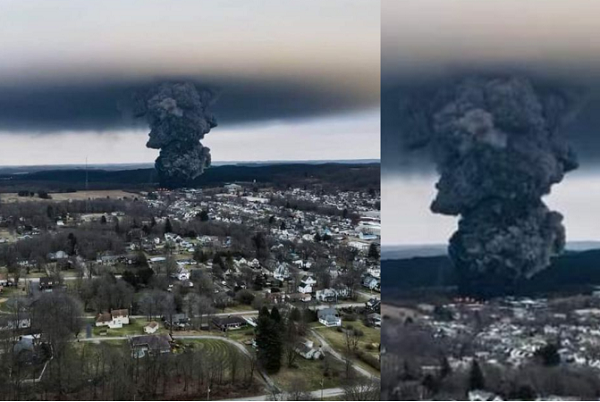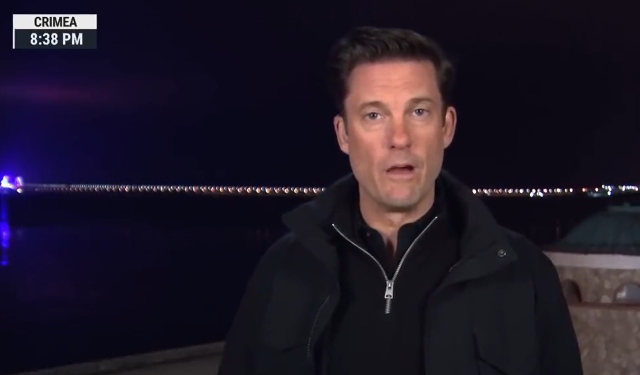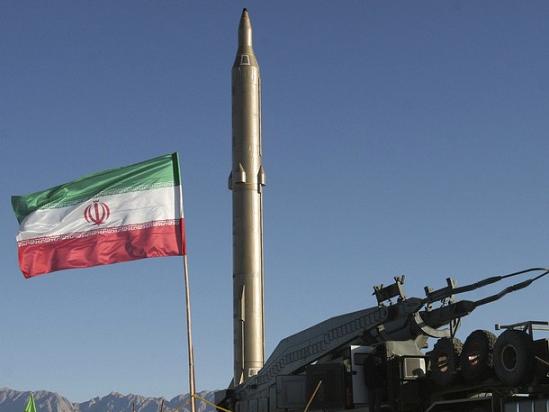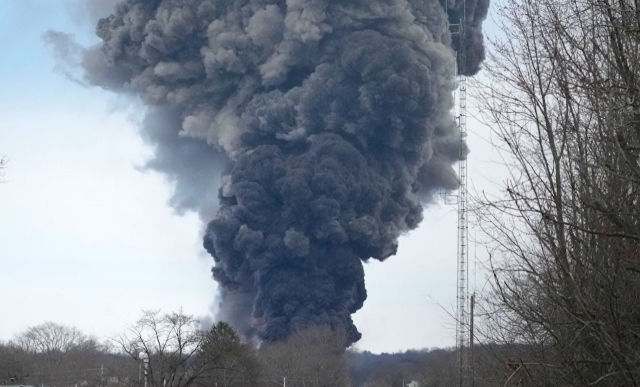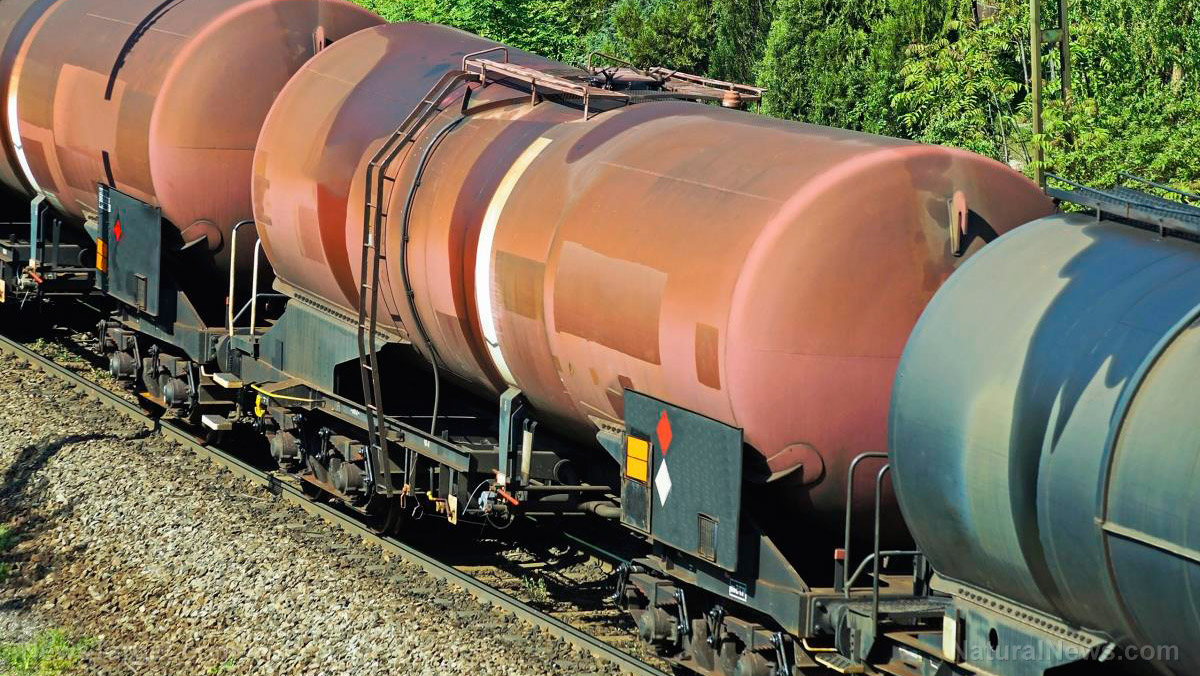Ohio train disaster exposes dark side of plastics
03/03/2023 / By News Editors
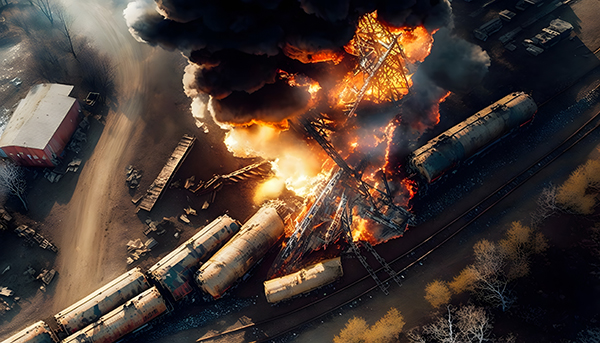
When officials decided on Feb. 6 to burn off the hazardous chemicals in Norfolk Southern’s derailed freight train in a “controlled burn” in East Palestine, Ohio, the fire released a plume of highly toxic chemicals — many of which are key elements in plastics production.
(Article by Brenda Baletti, Ph.D. republished from ChildrensHealthDefense.org)
The U.S. Environmental Protection Agency (EPA) reported that of the 20 railcars transporting toxic chemicals, at least five contained vinyl chloride — a carcinogenic gas used to make PVC (polyvinyl chloride) plastic.
The other railcars contained other chemicals used to make plastic, including butyl acrylate and ethylhexyl acrylate, which were all burned and released into the air, surface water and surface soils.
As of Feb. 16, a “chemical plume of butyl acrylate” was moving from the Ohio River toward Virginia, according to the Ohio EPA and Gov. Mike DeWine.
Norfolk Southern, the company that owns the train, and the EPA, which is monitoring toxins released in the spill, repeatedly assured residents that levels of chemicals in the air and water are at levels below those deemed safe for human consumption.
But there is widespread concern about safety, especially given the confirmation that 3,500 fish died in local streams, numerous reports of other dead animals, and resident complaints about lingering headaches and irritated eyes.
There are still many unknowns about how many chemicals were released and how they may be affecting the environment.
“As with most environmental spills, it is difficult to determine the exact amount of material that has been released into the air, water, and soil,” James Lee, an Ohio EPA spokesperson, told BuzzFeed.
Crews have been digging up soil and pumping out water from a 1,000-foot swath around the track. Norfolk Southern on Monday said 15,000 pounds of contaminated soil and 1.1 million gallons of tainted water had been removed.
Rep. Jamaal Bowman (D-N.Y.), prominent environmental activists and local residents have been calling for an investigation into the chemicals released. Bowman tweeted:
Nearly 1 million pounds of vinyl chloride were on this train. Now, the EPA has confirmed it’s entered the Ohio River basin which is home to 25 million people.
This is one of the deadliest environmental emergencies in decades and no one is talking about it. https://t.co/HTsZhokEo4
— Congressman Jamaal Bowman (@RepBowman) February 13, 2023
The Ohio Environmental Council also underscored the need to continuously monitor the situation in order to fully understand the extent of the environmental and health effects.
“We know from decades of environmental injustices that Ohioans and Americans have experienced, that it takes time to understand the full picture of health impacts a community faces in the event of an environmental disaster,” Ohio Environmental Council said in a statement.
DeWine announced plans to open a medical clinic early next week in East Palestine to evaluate those who are worried and to analyze their symptoms.
EPA Administrator Michael Regan on Tuesday announced the EPA would “take control” of the disaster response. That means the EPA is using its authority under the federal Superfund law to require Norfolk Southern to clean up the contamination, the Associated Press reported.
Both moves came after frustrated residents and officials in Ohio and Pennsylvania widely criticized the Biden administration’s response to the situation.
Some wonder if this move goes far enough. Robert F. Kennedy, Jr., chairman and chief litigation counsel of Children’s Health Defense, tweeted:
Q: How do you make a vinyl chloride mushroom cloud over Ohio? Put a McKinsey consultant in charge of a captive agency. President Biden needs to fire @SecretaryPete Buttigieg + make regulators accountable. https://t.co/kVQ6OwqpeS
— Robert F. Kennedy Jr (@RobertKennedyJr) February 21, 2023
How dangerous are these chemicals?
According to the National Cancer Institute, vinyl chloride, the chemical released in the greatest quantity in the controlled burn, is associated with lymphoma, leukemia, brain and lung cancers, and angiosarcoma, a rare form of liver cancer.
It also can cause a nonmalignant liver disease known as TASH, or toxicant-associated steatohepatitis and may cause neurological symptoms, such as dizziness and light-headedness.
Vinyl chloride’s health risks have been known since the 1970s when several workers at a B.F. Goodrich factory in Rubbertown, a Louisville, Kentucky, neighborhood, developed the rare liver angiosarcoma, which led to the worldwide recognition of vinyl chloride as a carcinogen.
Vinyl chloride has been found in the air near PVC factories and hazardous waste sites, and can leach into groundwater.
The gas can be consumed by humans through inhalation. Outdoors, sunlight can break it down within 11 days of being released. But it can also be dispersed in water. If a water supply becomes contaminated with vinyl chloride, it can infiltrate homes that use that water source for drinking, showering, cooking or laundry.
The largest vinyl chloride train spill prior to East Palestine happened in 2012 when a train derailed in New Jersey releasing about 20,000 gallons of vinyl chloride. Hundreds of nearby residents and emergency workers went to local hospitals reporting coughs and neurological symptoms.
But in that case, the vinyl chloride did not burn.
When vinyl chloride burns, it releases hazardous chemicals phosgene and hydrogen chloride into the air.
Phosgene is a colorless gas with a pungent odor that can cause vomiting and breathing difficulties, and was once used as a weapon in World War I.
Hydrogen chloride is a colorless to yellowish gas with a strong odor and is known to cause skin, eye, nose and throat irritation.
Neil Donahue, Ph.D., professor of chemistry at Carnegie Mellon University, told the AP he worries the burning may have formed dioxins, which are created from burning chlorinated carbon materials.
“Vinyl chloride is bad, dioxins are worse as carcinogens and that comes from burning,” Donahue said.
Dioxins are a group of toxic chemical compounds classified as persistent organic pollutants, meaning they take a long time to break down once they are in the environment. The EPA reports they can cause cancer, reproductive and developmental problems, immune system damage and can interfere with hormones.
“The thing about dioxins is they’re potent at really low levels, and are persistent and bioaccumulative,” Ted Schettler, science director of the nonprofit Science and Environmental Health Network, told Wired.
“You don’t want dioxins deposited in the soil around East Palestine that are not going to go away, and are going to bioaccumulate in people who are exposed to it.”
EPA head Regan said he isn’t sure if the EPA is testing for dioxins.
The flames and the plume could have spread toxicants well beyond the disaster site. There have been numerous unconfirmed reports of fallout from the event across the northeast. The Ohio Chapter of the Sierra Club is tracking the fallout.
PVC plastic, a ‘toxic time bomb’
“Sadly, this is yet another painful reminder of the dangers of making, transporting, using, and disposing of chemicals in plastics, especially polyvinyl chloride (PVC) plastic” Toxic-Free Future, a nonprofit, said in a statement about the unfolding East Palestine catastrophe.
Thousands of research papers have linked chemicals used in plastics to a host of environmental and health impacts. These include endocrine-disrupting compounds that cause problems in the body’s hormonal systems and are linked to reproductive issues, obesity, diabetes, ADHD and autism.
They also include microplastics, which are linked to respiratory, immune, reproductive and digestive system problems and increased cancer risk.
A report published last year by Minderoo Foundation estimated the plastics industry is costing society around $100 billion annually in environmental clean-ups, ecosystem degradation, shorter life expectancy and medical treatments.
PVC is widely considered to be the most toxic plastic, releasing dioxin and phthalate plasticizers at every phase of its life cycle. It is one of the most commonly used and discarded forms of plastic, despite the fact that its toxic environmental and health effects have been extensively documented.
PVC is most commonly used in building materials like piping and vinyl siding, in medical devices and in packaging and consumer products.
The production process for PVC exposes workers and surrounding communities not only to vinyl chloride but also to asbestos and the industrial “forever chemicals” known as PFAS.
PVC is a key replacement material for lead pipes, despite evidence that it leaches chemicals into the water supply and that pollutants from soil and water can pass through the pipe walls.
The Center for Biological Diversity has been pressing the EPA since 2014 to regulate PVC waste as hazardous, calling it, a “toxic time bomb” and “the most hazardous consumer products ever made.”
In January, the EPA tentatively denied the request, arguing that regulations would not have a meaningful impact and that the agency didn’t have the time or resources to create new PVC regulations.
“As long as we continue to use PVC, we will continue to have accidents like this and it is entirely preventable,” Emily Jeffers, an attorney at the Center for Biological Diversity, told Inside Climate News.
“If we regulate PVC as the hazardous waste that it is, that could potentially force producers to develop materials with less toxic properties,” she added.
But according to a report published last week by The Intercept, lobbying by industry groups like the Vinyl Institute, which have poured millions of dollars into convincing lawmakers and the public that PVC is safe, makes it challenging to regulate the chemical.
Lobbyists include a number of high-profile people with deep ties to the Democratic establishment, along with at least one former employee from the Trump presidential campaign.
Funders include petrochemical giants like Formosa Plastics, Westlake, Shintech Inc., and OxyVinyls, an affiliate of Occidental Petroleum’s OxyChem subsidiary.
These companies have been cited 245 times for safety and environmental violations and paid over $50 million in fines. They’ve also faced civil lawsuits.
The Vinyl Institute has lobbied against efforts to ban toxic chemicals and decrease reliance on plastics. The report says that because of its “strong congressional allies,” the PVC industry is poised for massive expansion.
Another industry cover-up?
Despite the EPA’s announcement that it has taken control of the cleanup, Norfolk Southern is still the entity entirely responsible for carrying it out.
The rail company hired private contractor CTEH (Center for Toxicology and Environmental Health), to test air, water and soil quality in East Palestine. According to Mother Jones, The New York Times and Kanekoa News, the company has a history of minimizing the effects of environmental disasters to protect corporations.
CTEH was accused of mishandling data collection in a crude oil spill that happened during Hurricane Katrina, a coal ash spill in Tennessee, a case of defective Chinese drywall affecting Florida Homeowners and the BP oil spill in 2010.
In all of those cases, the Big Chemical corporations used CTEH’s findings to assure people that the chemicals spilled posed no risk to public health — when in fact they did.
Northfolk Southern also hired CTEH when one of its trains derailed in Graniteville, South Carolina, releasing 90 tons of chlorine gas that killed nine people.
The Times reported when CTEH confirmed BP’s assertion that there were “no significant exposures” in the BP oil spill in the Gulf of Mexico, Nicholas Cheremisinoff, a former Exxon chemical engineer who now consults on pollution prevention said, “It’s essentially the fox guarding the chicken coop.”
According to the Times:
“Another toxicologist familiar with CTEH, who requested anonymity to avoid retribution from the firm, described its chemical studies as designed to meet the goals of its clients.
“‘They’re paid to say everything’s OK,’ this source said. ‘Their work product is, basically, they find the least protective rules and regulations and rely on those.’”
CTEH even provided analysis for Chevron-Texaco when it was sued by tens of thousands of indigenous people for failing to clean up the oil spill on their land in Ecuador.
In that case, CTEH found there was no evidence that the oil spill was related to the health outcomes. Chevron lost that case in an Ecuadorian court.
In East Palestine, there were several reports that residents having their homes tested by CTEH have been asked to sign waivers saying they would not hold Norfolk or their affiliates, including CTEH, responsible for any future liabilities.
One resident told Glenn Beck that 340 residents signed the contracts.
Kanekoa News tweeted a description of its interaction with CTEH:
#28 Katlyn Schwarzwaelder tells Glenn Beck four of her dogs were projectile vomiting, her eyes and throat get itchy and burn when she visits her home, and she plans to abandon East Palestine forever because of her long-term health concerns:
“I had four https://t.co/8lBlOhcAtZ… https://t.co/ph4pUGAIgt pic.twitter.com/sFeYdv3jjm
— kanekoa.substack.com (@KanekoaTheGreat) February 15, 2023
Read more at: ChildrensHealthDefense.org
Submit a correction >>
Tagged Under:
big government, cancer criminals, chemical disaster, conspiracy, deception, dioxin, ecology, environment, microplastic, national security, Norfolk Southern, ohio, plastics, poison, products, rigged, toxic chemicals, toxic ingredients, toxins
This article may contain statements that reflect the opinion of the author
RECENT NEWS & ARTICLES
COPYRIGHT © 2017 NATIONAL SECURITY NEWS





